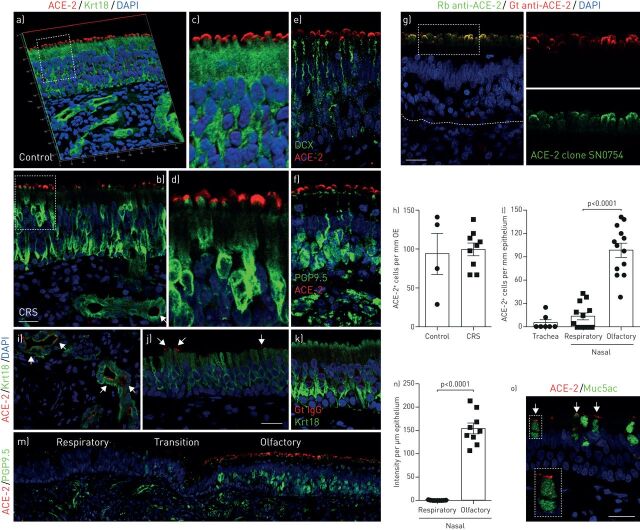FIGURE 1.
Cellular location of angiotensin-converting enzyme 2 (ACE-2) in human nasal and tracheal biopsies. a–d) Confocal image of ACE-2 (red) and Krt18 (green) immunostaining in the olfactory neuroepithelium from healthy control (a and c) and chronic rhinosinusitis (CRS) patient (b and d). The three-dimensional image (a) shows that the ACE-2 is localised to the apical surface of Krt18-positive sustentacular cells in the olfactory epithelium. Confocal images were obtained under Z stack mode which covered 8 µm in depth. The boxed area in panel (a and b) was highlighted in (c and d), respectively. e and f) The location of ACE-2- and DCX-positive immature (e) or PGP9.5-positive mature (f) olfactory sensory neurons in control. g) Confocal image verified the apical expression pattern of ACE-2 by co-staining of Goat anti-ACE-2 and another Rabbit anti-ACE-2 antibody (clone SN0754). The boxed area in (g) was highlighted in right panels. h) Quantification of ACE-2-positive cells per mm olfactory epithelium (OE). At least three images were collected from each specimen (four controls and nine CRS biopsies) using 40×objectives under the Z stack scan mode at same depth. i and j) Expression of ACE-2 in glands (i) and nasal respiratory epithelium (j). k) No detectable signal in Goat IgG isotype control. l) Quantification of ACE-2-positive cells per mm epithelium. The positive cells in seven tracheal biopsies and 13 nasal specimen that contained both respiratory and olfactory epithelium were counted. m) Representative image of respiratory-olfactory mucosa adjacent area. PGP9.5 and ACE-2 co-staining image was obtained using confocal microscope under the tile scan mode. n) Quantification of the ACE-2 fluorescence intensity per µm epithelium. Nasal specimen that contained both respiratory and olfactory epithelium were quantified using Image J. o) Co-staining of ACE-2 and secretory cell marker Muc5ac in tracheal airway epithelium. The inset represents magnification of the selected area. Dots in graph represent independent specimens (h, l and n). Data are represented as mean±sem. p-value was calculated by unpaired two-tailed Student's t-test. Differences were considered significant when p<0.05. Scale bars: 20 µm.

